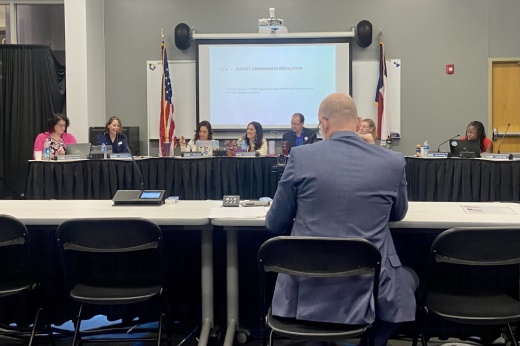The estimated shortfall has decreased by $5 million since the district’s original projections; however, district officials said a lack of state funding has put LISD in a difficult situation as its budget tightens.
“We have a lot of tough decisions to make, but I want you to know they are being made strategically, and a lot of thought processes [are] going into how and when these decisions are made,” Chief Financial Officer Pete Pape said at an April 25 meeting.
The breakdown
The district’s budget projections include $446.58 million in revenues and $460.35 million in expenditures. Additionally, the district will transfer $1.28 million to other district funds resulting in a $15.05 million budget shortfall. The projected shortfall exceeds the district’s budget parameter—set at 3% of revenues—by almost $2 million.
The shortfall has decreased by $5 million since the district originally projected a nearly $20 million shortfall in January. The updated projections account for the following:
- An increase of 252 additional students from previous enrollment projections due to the addition of 14 prekindergarten classes
- A reduction in allocated funding for the new police department
- The removal of startup salaries for Elementary School No. 31
- A $6 million increase in revenue through Senate Bill 2
Additionally, district officials removed 22 full-time positions initially budgeted for next year, including 20 bus driver positions that were not needed, Pape said.
District staff would receive a 2% pay raise under the proposed budget, which district administration recommended at the meeting.
Diving in deeper
The district expects to receive $6 million more from the state than it originally projected due to SB 2. The new state law lowered the district’s maintenance and operations tax rate, which has reduced its overall recapture payment to the state, Pape said.
As the district is yet to hire a chief for its new police department, LISD will transfer the $1.1 million in approved funding for the department this fiscal year to FY 2024-25, Pape said. The $3.3 million in department-related expenses that were allocated for FY 2024-25 will be pushed to the following fiscal year, he said.
The district hopes to hire a chief sometime this summer and begin hiring officers in late fall or early spring, Pape told Community Impact.
The FY 2024-25 budget would no longer include $150,000 in startup salary costs for Elementary School No. 31, which was expected to open in 2025, according to the district's website. Pape said the district is forecasting to push the school’s opening back a year; however, Superintendent Bruce Gearing said the district’s Long-Range Planning Committee determined the earliest the school could open was August 2027.
The district committee is yet to make a final determination on the school’s opening date, Place 4 board member Anna Smith said.
In their own words
District officials expressed frustration over not receiving sufficient state funding despite the Texas Legislature having a multibillion-dollar surplus in 2023.
“I think it’s just unfortunate that we keep finding ourselves in this situation again, because with such a huge surplus there was no additional funds allocated to education compared to 2019,” Place 5 board member Sade Fashokun said.
Inflation has increased by 19%-20% since 2019 while the basic allotment of funding per student has remained unchanged, Pape said. The district will need to carefully evaluate every position and explore how to improve efficiency to offer the same programs with fewer staff members, Pape said.
Going forward
Moving forward, Pape said the district will look to make improvements over time, such as raising salaries “slowly, methodically and strategically.”
“This will put us in the position to attract the best talent; be the most competitive on our compensation; [and] provide the biggest and best, broadest programs for our students,“ Pape said. “We’re not going to lose sight of where we want to be.”
The board of trustees will vote to adopt the FY 2024-25 budget at its June 27 meeting, Pape said.





